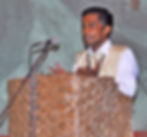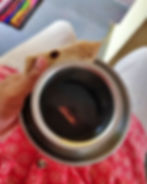What can Traditional Fishing Communities Teach us about Sustainability?
- Srilaxmi
- Apr 1, 2022
- 6 min read
Updated: Sep 21, 2022
Parindey: Mahendra Paradkar
Alivelihood: Conservation and Community Rights Activism
Region: Dandi, Sindhudurg district, Maharashtra

Mahendra Paradkar was born in Dandi, a coastal gaon (village) in the Konkan belt of Maharashtra. The primary occupation here is fishing, which has been passed on through the generations and is an integral part of their lives and livelihoods. Mahendra was one of the few of his generation to have received and continued formal education, and it was important for him to get a job. However, he did not want just any job. In college, he wrote for a college-edition supplementary newsletter of Tarun Bharat, a widely read Marathi newspaper. “My classmates, professors, and others around me enjoyed reading my articles and encouraged me to keep writing. Motivated by their consistent feedback, I considered pursuing a career in journalism.” Based on his work, he was offered a four-month training in journalism at Tarun Bharat, which kick-started his career in journalism. He enjoyed covering stories ranging from politics to culture to education; however, his focus remained the one thing that connected him to his roots—fishing. It was important for him to actively take up issues pertaining to this and amplify them because writing was not only his passion but also a means of providing a platform to the traditional fishing communities of Malvan, which are now struggling owing to excessive industrial fishing.

When he was a child, Mahendra’s father would wake him up just before sunrise to have his favourite breakfast of chai and freshly baked chapatis. Mahendra would go back to sleep after eating, and his father would go hook-and-line fishing to catch shengti or catfish, which was a specialty that was caught using this technique. On the weekends, if the catch was good, he and the other kids would gobble down their lunch and run to the markets where the boats would dock and sell their catch. Children used “seeing the shengti'' as an excuse to go and eat Bengali khaja, a sweet sold at the stalls nearby. They would also take home some of the day’s catch for dinner. Shengti is now a rarity, with its population dwindling due to extensive mechanised fishing. Consequently, the memory associated with Bengali khaja and shengti is now lost. “Several experiences can be lost with the loss of just one fish. This saddens me because the present generation has not been able to witness what I experienced as a child.”

Mahendra practises dialectical reporting. “I try to understand both sides of the story and balance them out while writing because I am a journalist. However, when it comes to industrial fishing, I have no two opinions about it.” He believes that his work on non-mechanized fishing is not against someone or something and that it focuses on creating an impact to regulate the manner of fishing today. “If there is a ban on fishing during a certain season, it should be followed strictly. Strong winds and rough seas during the monsoons are our planet’s way of saying that this is break time; the time to replenish and regenerate. However, fishing still happens. Why?” Monsoon is the main breeding season for most creatures that inhabit these waters. Earlier, people used wooden boats and would not venture into the sea during monsoons. However, motorised boats are now slowly wreaking havoc by disregarding these age-old practices. Although most fishing communities across the country have switched to industrial modes of fishing, Dandi is one of the few villages that still practises the traditional way.
“The thing about Dandi is its strength as a unit. We come together for anything and everything. People from the outside fear this about us,” says Mahendra. This togetherness guides the community of Dandi. All matters, especially those concerning the fisher folk, are deliberated at Chowkchar mandir, the local temple. Here, where the people of the village decide their future, everybody assumes the sole identity of a fisherfolk, irrespective of their social and financial status. This tradition of a grassroots democracy of sorts began with a major event that took place in 1960 when the Malvan municipality imposed taxes on fishing. At that time, the late Dnyanesh Devulkar, a teacher from a fishing community, brought all the fishing communities of Malvan together to protest the imposition of tax in front of the Malvan Nagar Parishad building where it was initiated. This was the first time that all the fishing villages in this part of the coast had come together. Stirred by success, the communities grew stronger in voicing their concerns. However, today, with purse seine nets, high-speed trawlers, and LED boats emptying the sea in large quantities even in the off-season, the traditional fishing communities are not only suffering but also dwindling. “The only reason some traditional fishing communities are still surviving and fighting against the injustice of excessive mechanised fishing is that a few people like Mahendra still believe in and strive for sustainable fishing,” says Devulkar’s daughter, Charushila Devulkar, a social worker and counsellor.

After an 11-year period with Tarun Bharat, Mahendra resigned from his position as Chief Representative of Malvan to focus his full attention on converting the 2012 recommendations of the Somvanshi Committee into law. This committee was formed in 2011 to study the impact of purse seine nets on traditional fishing communities and the ecology of Maharashtra’s coast. In 2016, with the Fadnavis government in power, Mahendra and his team’s efforts were successful, resulting in the creation of a Notification under the Maharashtra Marine Fishing Regulation Act dated February 5, 2016.

During this time, Mahendra also joined hands with a Mumbai-based NGO, Vikas Adhyayan Kendra, which had launched a programme focusing on the welfare of women in fishing communities. The role of women in fishing often tends to fall beyond recognition and/or acknowledgment. Fishing involves more than just going out to the sea and laying nets for the fish. Once the boat comes back from the sea, the women gather around the boat to remove the fish from the nets, segregate them, store them in ice boxes, and take them to the market early the next morning. Further, the famous monsoon diet of dry fish in the Konkan region is the outcome of women’s efforts in sun drying them. They also shoulder the responsibility of feeding the household. However, upon conducting a survey of women along the Sindhudurg coast, Mahendra, along with the NGO, found that most of the women had lower than normal levels of haemoglobin. Those who lived in remote coastal villages that did not have access to ice to store fish would hardly get 2–3 hours of sleep at night and the women who spent afternoons selling fish at the market usually had bhajji and chai for lunch, resulting in low levels of haemoglobin and iron. “We are pushing the State government to establish Poli Bhaji Seva Kendra near the markets to ensure a nutritious meal for women in the market itself. Work is also underway for facilitating leadership training for women in the society to enable them to gain opportunities.” Mahendra also rejoined Tarun Bharat last year as a reporter. “I have some things to write, and I think I shouldn’t let go of that.” Alongside writing, he has started documenting issues through videos.

Mahendra looks back at his childhood days and says, “If I have to credit someone for inspiring me to do what I do, it would be my history teachers throughout school and college. Reading about figures such as Mahatma Gandhi, Lokmanya Tilak, and Chatrapati Shivaji Maharaj inspired me to fight for the truth; to fight for what is right.” His hopes extend beyond individual dreams to community-based aspirations. He hopes that more of the village children, especially the girls, receive good education and work towards promoting traditional methods of fishing, conserving marine biodiversity, and sustainable tourism.
He also aspires that the traditional fishers remain strong in the face of capitalist expansions that perceive fishing as a secondary business venture. The question that is often asked by the fishers who have moved to mechanised fishing is, “If others are exploiting our fish, why can’t we?” Upon close observation, one can see the multiple layers to the impact industrial fishing has on communities and biodiversity. Mahendra believes that everyone is entitled to a good life but not the kind that is being promoted today. “One should be happy with what they are doing. I don’t demand that motorised fishing be banned. What I do say is, give priority to the communities that have practised this skill for so many generations, because we are emotionally and socially tied to the oceans. Give priority to the biodiversity of the oceans to ensure it is thriving, be it fish populations or coral reefs, because we can’t just take, take and take. We have to give back as well,” says he.

Mahendra can be reached at: tbdmahendra@gmail.com
Website: https://tarunbharat.com/
Follow them on social media: https://www.facebook.com/Tarun-Bharat-News-Sindhudurg-102398094970386
